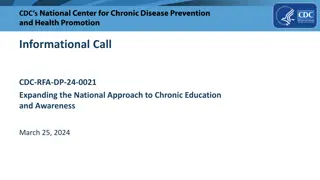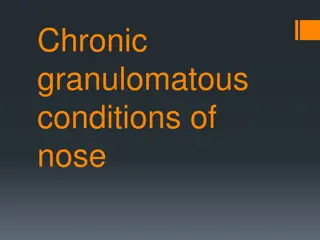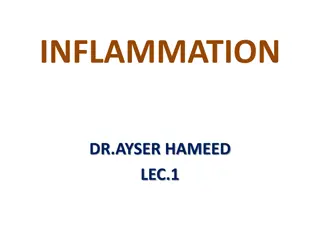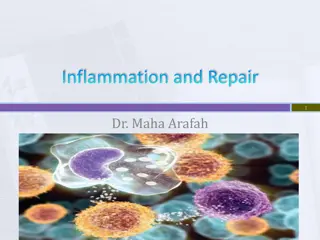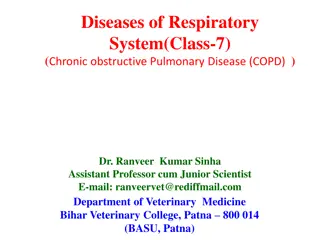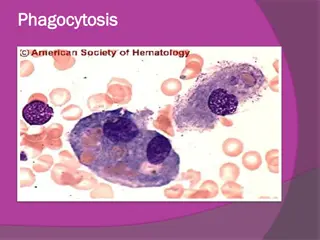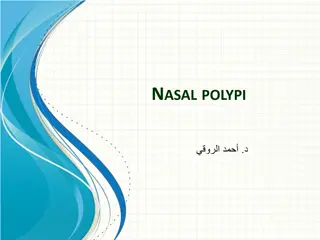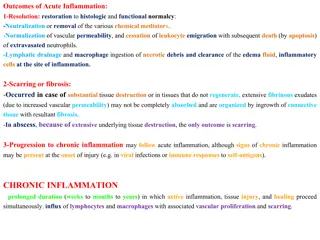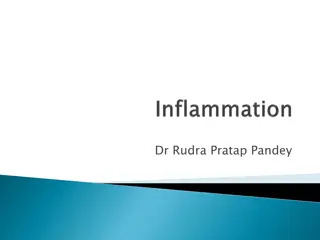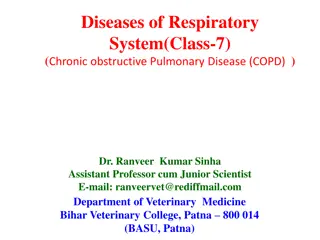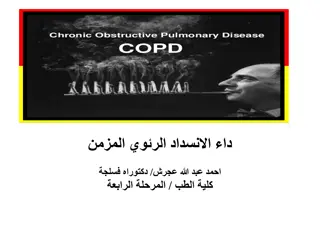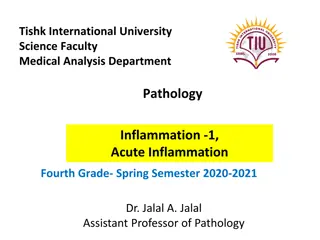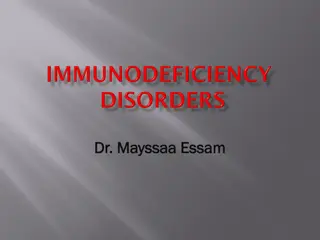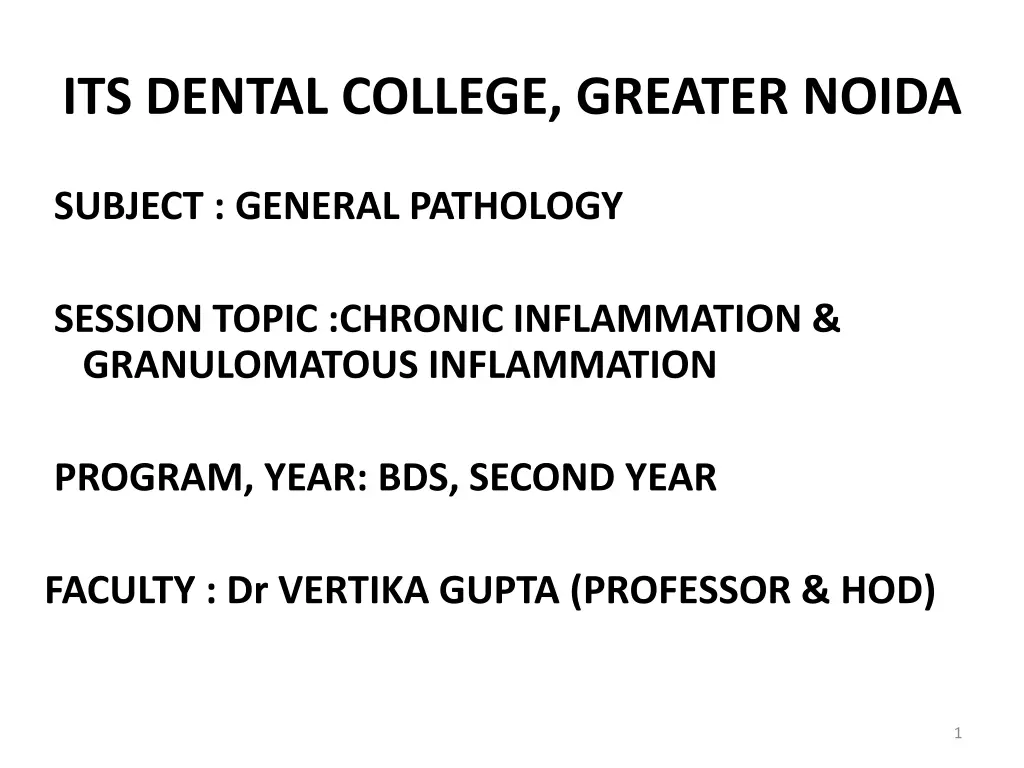
Understanding Chronic and Granulomatous Inflammation in General Pathology
Explore the definitions, causes, types, and morphologic features of chronic and granulomatous inflammation in the context of general pathology. Delve into the infiltration by mononuclear cells and the role of macrophages in tissue injury and inflammation. Gain insights into chronic cervicitis and the processes of fibrosis and angiogenesis. Join Dr. Vertika Gupta at ITS Dental College, Greater Noida, on this educational journey.
Download Presentation

Please find below an Image/Link to download the presentation.
The content on the website is provided AS IS for your information and personal use only. It may not be sold, licensed, or shared on other websites without obtaining consent from the author. If you encounter any issues during the download, it is possible that the publisher has removed the file from their server.
You are allowed to download the files provided on this website for personal or commercial use, subject to the condition that they are used lawfully. All files are the property of their respective owners.
The content on the website is provided AS IS for your information and personal use only. It may not be sold, licensed, or shared on other websites without obtaining consent from the author.
E N D
Presentation Transcript
ITS DENTAL COLLEGE, GREATER NOIDA SUBJECT : GENERAL PATHOLOGY SESSION TOPIC :CHRONIC INFLAMMATION & GRANULOMATOUS INFLAMMATION PROGRAM, YEAR: BDS, SECOND YEAR FACULTY : Dr VERTIKA GUPTA (PROFESSOR & HOD) 1
Learning Objectives & Specific Learning Outcomes General Objectives: To describe chronic Inflammation & granulomatous Inflammation. Specific Learning Outcomes: At the end of the lecture, the learner should have the knowledge about Chronic Inflammation & Granulomatous Inflammation with respect to 1) Definition 2) Causes 3) Types 4) Morphologic features 5) Principal granulamatous conditions 2
DEFINITION Inflammation of prolonged duration (wks-mths-yrs) in which active inflammation, tissue destruction & attempts at repair are proceeding simultaneously. CAUSES 1) Chronic inflammation starting de novo 2) Following acute inflammation 3) Recurrent attacks of acute inflammation 4) Prolonged exposure to potentially toxic agents 5) Autoimmunity
MORPHOLOGIC FEATURES 1) Infiltration by mononuclear cells (Macrophages, Lymphocytes, Plasma cells) 2) Tissue destruction/ necrosis 3) Proliferative changes-Attempt at healing by connective tissue replacement of damaged tissue (angiogenesis, fibrosis)
1) INFILTRATION BY MONONUCLEAR CELLS MACROPHAGES , LYMPHOCYTES, PLASMA CELLS A) MACROHAGES (dominant cell, component of MPS/RES) - Tissue cells derived from circulating bld monocyte after their emigration from bld stream. - In all tissues, Macrophage acts as filters for particulate matter, microbes & senescent cells. Acts as sentinels to alert specific components of the adaptive immune system to injurious stimuli.
ACTIVATED MACROPHAGE TISSUE INJURY & INFLAMMATION -Reactive O & - GF (PDGF, FGF, TGF ) nitrogen species - Fibrogenic cytokines - Proteases - AA metabolites - Coagulation factors - Cytokines including chemokines FIBROSIS - Angiogenesis GF
B) LYMPHOCYTES & PLASMA CELLS Mobilized in both Ab-mediated (B Lymphocytes) & cell mediated (T Lymphocytes) immune rxns & even in nonimmune inflammatory reactions. Plasma cells develop from activated B Lymphocytes & produce Ab against the Ag C) OTHER CELLS Eosinophils, mast cells
2) TISSUE DESTRUCTION (central feature) By activated macrophages 3)PROLIFERATIVE CHANGES - ATTEMPT AT HEALING BY CONNECTIVE TISSUE REPLACEMENT OF DAMAGED TISSUE (fibrosis , angiogenesis)
SYSTEMIC EFFECTS OF CHRONIC INFLAMMATION FEVER mild often with loss of wt & weakness ANAEMIA LEUCOCYTOSIS lymphocytosis ESR elevated AMYLOIDOSIS secondary systemic (AA) amyloidosis
TYPES OF CHRONIC INFLAMMATION 1) CHRONIC NONSPECIFIC INFLAMMATION 2) SPECIFIC / GRANULAMATOUS INFLAMMATION
GRANULAMATOUS INFLAMMATION GRANULOMA is a focus of chronic inflammation consisting of a microscopic aggregation of macrophages that are transformed into epithelial like cells (epithelioid cells) & are surrounded by collar of mononuclear cells mainly lymphocytes & occasional plasma cells.
TYPES OF GRANULOMAS 1) FOREIGN BODY GRANULOMAS are incited by relatively inert foreign bodies eg talc , sutures etc 2) IMMUNE GRANULOMAS by microbes which are poorly degradable / particulate eg TB (central caseous necrosis) , sarcoidosis , syphilis, leprosy etc
PRINCIPAL GRANULAMATOUS CONDITIONS A) BACTERIAL 1) TB Both caseating & noncaseating granulomas 2) LEPROSY noncaseating epithelioid cell granuloma 3) SYPHILIS gumma ( histiocytes, plasma cells, central necrosis) 4) BRUCELLOSIS nonspecific granulomas 5) CAT SCRATCH DIS granulomas with central caseation
B) FUNGAL 1) ACTINOMYCOSIS- Granuloma with draining sinuses (sulphur granules) 2) BLASTOMYCOSIS- Ulceration with granuloma formation 3) CRYPTOCOCCOSIS 4) COCCIDIODOMYCOSIS C) PARASITIC SHISTOSOMIASIS- Granulomatous reaction present
D) MISCELLANEOUS 1)SARCOIDOSIS noncaseating granulomas 2) CROHNS DISEASE noncaseating granulomas 3) SILICOSIS 4)BERYLLIOSIS noncaseating granulomas 5)FOREIGN BODY GRANULOMAS noncaseating granulomas
Frequently asked Questions 1) Short notes on - Chronic inflammation - Granuloma or Granulomatous inflammation - Principal granulamatous conditions 2) Diagram of granuloma (lymph node, lung etc) 21
Reading List/Reference List Robbins Basic Pathology: Kumar, Abbas, Aster, 9th Edition Essential Pathology for Dental Students: Harsh Mohan, Sugandha Mohan, 5th Edition 22



